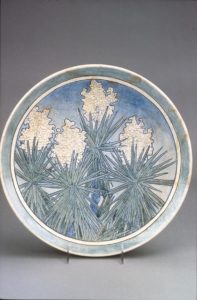Mary Sheerer
Designer Mary Sheerer was a major influence on Newcomb Pottery, an art form she once described as "made of Southern clays, by Southern artists, decorated with Southern subjects."

Courtesy of Newcomb Art Collection, Tulane University.
This "Spanish Dagger Plate" from the Newcomb Pottery School was made with low-fire white clay with blue and green underglaze and glossy glaze by Joseph Fortuné Meyer and decorated by Mary Sheerer.
Hired as a new graduate of the Cincinnati Art Academy in Ohio, inventive ceramics designer, china painter, and educator Mary Sheerer was a major influence on Newcomb Pottery, an art form she once described as “made of Southern clays, by Southern artists, decorated with Southern subjects.” Sheerer developed Newcomb’s earliest glazes starting in 1896 with tubs of clay from the Bogue Falaya River across Lake Pontchartrain from New Orleans. In the summer of 1925 Sheerer was designated to attend the Exposition of Decorative Arts in Paris, where she observed science- and mechanics-oriented designs of right angles and triangles that inspired Newcomb’s later abstract designs.
